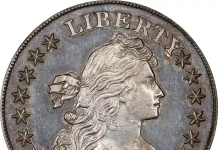SPECIAL OCCASIONS CAN BE RECOGNIZED WITH PRECISION
CryptoCoinage
BY JAMES McCARTNEY
“All loaded physical bitcoins feature an inherent timestamp of their production that is captured on the blockchain for eternity.”
Imagine being able to acquire a rare and valuable coin that was struck on the day, date and time of your birthday. To be clear, we’re talking not just about the year or the month, but the precise day and exact time. Or maybe you want a numismatic keepsake to mark your wedding day or the moment your grandchild was born. While this is virtually impossible to accomplish with conventional coins, it is a very real possibility in the category of Physical Bitcoins and Cryptocurrency.
PHYSICAL BITCOINS AND CRYPTOCURRENCY HAVE A BUILT-IN TIMESTAMP
Though some Early American issues are documented to have been struck on a particular date or timeframe, the vast majority of coins remain more ambiguous as to their exact production. For example, the iconic New England shillings were first struck in September 1652 and continued to be produced until new legislation was issued on October 19th that changed the design. We know that the legendary 1794 Flowing Hair dollars were likely struck or manufactured on October 15, 1794, give or take a day. But as you get further into the Federal Era, mintage figures increased and detailed production records became impractical. Even Thomas Jefferson might have had difficulty tracking down a new 1801 $10 Gold Eagle struck precisely on his inauguration day of March 4th of that year.
Jefferson would have had no problem if physical bitcoins had come to prominence only a few centuries earlier. All loaded physical bitcoins feature an inherent timestamp of their production that is captured on the blockchain for eternity. While the intricacies of the blockchain can sound overwhelming, it is simply a public ledger that records all transactions in and out of each “wallet” or address. Each physical bitcoin has a unique address associated with it, so when the coin is loaded by the producer or owner, that action is recorded for eternity.
BLOCKCHAIN TRANSACTIONS CAPTURED FOR ETERNAL OBSERVATION
Though there is clearly a novelty in hunting down a coin that was created on a date that is personally meaningful, this timestamp can also designate coins that are important within the context of the category or numismatics as a whole. For example, Stack’s Bowers Galleries sold a Casascius 1 Bitcoin that was loaded on October 17, 2011, less than two months after the start of the Casascius series on September 6th that year. This early loading date distinguished it as one of the very first coins stuck of the entire physical crypto category. This characteristic might have contributed to the record selling price of $108,000, which set a record at the time for the most valuable 1 Bitcoin ever sold.
Stack’s Bowers also presented a 25 Bitcoin from the Casascius series that was loaded on December 7, 2011. However, that coin was later redeemed by the owner on March 6, 2014, when Bitcoin was approximately $450. Though the redeemed value of $11,000 represented an astounding profit compared to the original loading amount of around $100, that same 25 Bitcoin would be worth around $2,000,000 today. The redeemed coin was sold at auction by Stack’s Bowers for $2,190, demonstrating that these objects remain desirable for their rarity and historic significance even if they have been redeemed and there is no associated cryptocurrency. For better or worse, these transactions are all captured on the blockchain for collectors, investors and historians to observe for eternity. It is one of the many unique features that makes this new numismatic category so fascinating and engaging to pursue.
James McCartney is director of consignments and numismatics at Stack’s Bowers Galleries.












